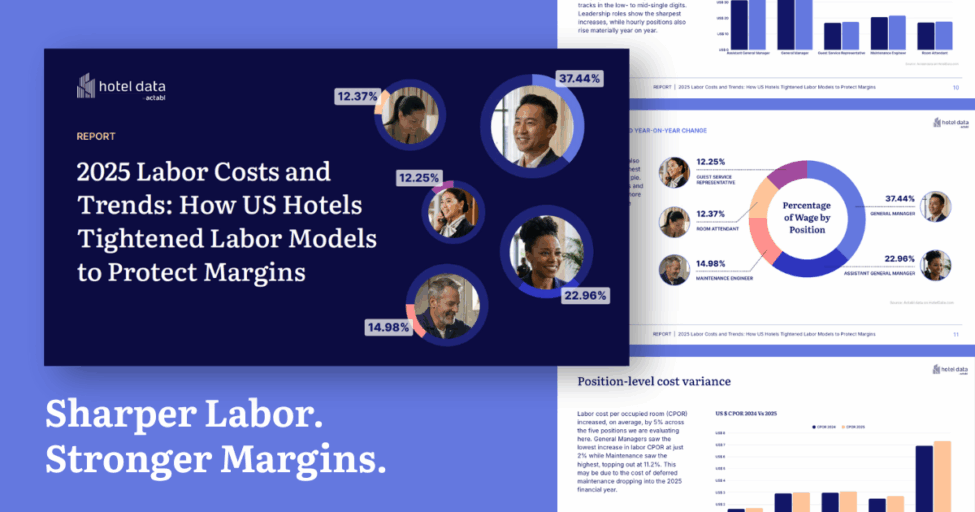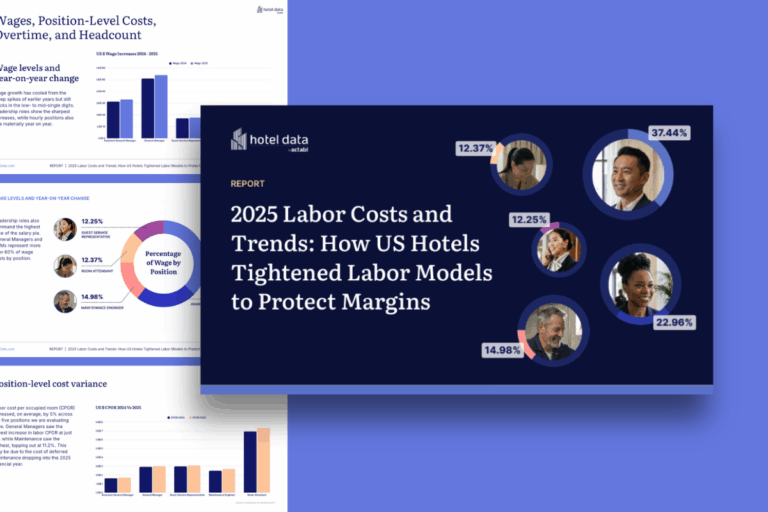
From Cost to Catalyst: Rethinking Hotel Labor Strategies for 2026 and Beyond
Labor represents both the most pressing challenge and the greatest opportunity for driving profitability, enhancing guest satisfaction, and maximizing asset value in hotels.
A recent webinar hosted by Hotel Investment Today by Northstar and Actabl saw four hospitality leaders come together to explore how data, technology, and culture are reshaping labor strategies for the years ahead. Their discussion underscored a shared belief: effective labor management is no longer just about cost control; it is a catalyst for long-term growth and success.
Webinar participants:
- Charles Oswald, CEO of Aperture Hotels
- Chris Tatum, President of the Full-Service Division at Aimbridge Hospitality
- Kirk Pederson, President of Sightline by PM Hotel Group
- Shanell Marinuzzi, Account Manager at Actabl and former hotel GM
- Moderator: Mary Scoviak, Content Director, Hotel Investment Today
Explore the full conversation produced by Hotel Investment Today. The webinar is available to watch on demand.
Labor Trends Shaping the Industry
Scoviak kicked off the discussion by asking each panelist to identify three key trends that will influence labor decisions in 2026 and 2027.
For Oswald, the future is shaped by the rise of AI, erosion of EBITDA, and rising expectations from both employees and guests. As he explained, “It's fantastic now that new technology helps us to better measure and manage labor. AI is probably the biggest competitive advantage for any innovative company today. It enables productivity.
“EBITDA erosion is largely driven by wage growth, which outpaces CPI, which is outpacing RevPAR growth. There are tools out there that can help us benchmark our pay rates to make sure that they're at the right competitive level in each of our sub-markets.
“And when I say people expect more, I think it's both customers and employees. So, customers, we've seen some revenue bifurcation and growth in RevPAR, which differs for those experiential hotels versus limited service properties. And then with our labor, they're expecting more, better work/life [balance], better experiences, quality, and rewards.”
Tatum echoed the importance of productivity, but also emphasized workforce flexibility and career development. He noted that younger employees are increasingly seeking flexible schedules and opportunities for growth without requiring relocation. Retaining associates by meeting those needs has become essential to performance and recruitment.
Pederson pointed to the shrinking labor pool, rising dependence on contract labor, and the central role of workplace culture. He reminded attendees that engagement and culture directly support profitability, and that reliance on third-party staffing can erode both quality and margins.
From her perspective, working directly with operators on technology adoption, Marinuzzi highlighted the squeeze on profit margins, rising labor costs, and the need to right-size staffing with the help of analytics. She added that those who embrace technology and disciplined labor practices are consistently outperforming their peers.
The Cost of Turnover
Turnover emerged as a consistent theme throughout the conversation. Tatum described the financial and operational toll of losing staff, especially in skilled roles. He explained, “We’re focusing on the things that we can control. We can control overtime, which is a real focus for us. And also, we talk a lot about retention. Turnover is devastating to the profit of hotels, and really thinking through on what motivates our team to stay and how do we do it… that’s the only way we’re going to get around the challenges of wages.”
From training costs to service disruptions, turnover not only strains budgets but also risks eroding guest satisfaction. The panelists agreed that the solution lies in retention strategies—investing in people, fostering a culture of belonging, and ensuring career pathways are visible and attainable.
The Role of Technology in Labor Management
Technology was presented not as a silver bullet, but as an enabler of smarter decisions and greater efficiency. Oswald described how Aperture Hotels uses labor management systems to track productivity, benchmark against standards, and reduce the risk of poor financial outcomes.
Marinuzzi added that data accuracy and integration are critical. She explained that many operators still struggle with blind spots when using spreadsheets or siloed tools. Her own experience showed the difference technology can make: “When I finally embraced technology, in my first year, I reduced overtime by 50%. That wasn’t just efficiency, that was money back to my bottom line at my property.”
For her, the key is not just adopting software, but ensuring teams know how to use it consistently, integrate it with property management and POS systems, and conduct weekly labor meetings to keep performance on track.
Forecasting and Flexibility
With compressed revenues and shorter booking windows, forecasting has never been more important. Tatum explained how Aimbridge uses balanced scorecards and improved forecasting tools to align teams and owners around common goals. He argued that operators must link turnover costs directly to GOP impact to encourage accountability at the property level.
Oswald and Marinuzzi agreed, emphasizing that consistent forecasting, supported by standardized tech stacks across portfolios, drives both efficiency and cultural alignment.
Investing in People
The discussion circled back to culture as a cornerstone of profitability. Pederson stressed that employees want more than paychecks—they want to feel part of something meaningful.
“Employees want more out of a job than just a 9:00 to 5:00 and a paycheck. They want to feel like they’re part of something,” he said.
Training, flexibility, and recognition all contribute to a sense of belonging and motivation. In a competitive labor market, culture becomes not just a retention strategy but a differentiator for attracting top talent.
Looking Ahead
Despite the challenges, including rising wages and tighter margins, the panelists remained optimistic. With the right mix of technology, disciplined labor practices, and cultural investment, hotels can protect profitability even in a volatile environment.
Marinuzzi summed it up best: profitability is not luck, it is discipline. Data-driven strategies, clear cultural priorities, and consistent use of technology can transform labor from a cost center into a catalyst for growth.
- Watch the discussion anytime: The full webinar is now available on demand here.





